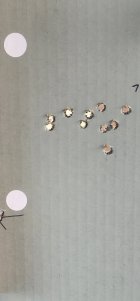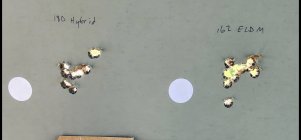ShtrRdy
Silver $$ Contributor
@Lead Slanger -- if you have a 600 yard range available, and if there are times when it's not windy, Ryan Furman likes to use this method.
Good post. I appreciate the info and the time it took to reply. Thank you, sir.I've got lots to learn. But, here's what I can share...
I've tried the satterlee method when it was popular & it didn't pan out for me. As others have mentioned, when sample sizes are small, results are statistically insignificant (and therefore likely not repeatable). If you decide to increase sample sizes and do a velocity ladder with 4-5 cartridges per charge weight (CW), one might argue that you might as well be doing OCW.
There seem to be two major schools of thought for load development methodology. (1) OCW then fine tune seating depth, (2) seating depth tests at lowest book CW, then OCW at that optimal seating depth. I've done it both ways and gotten to the same place. I don't personally feel like either method is really faster or uses less components...unless you just get lucky and hit gold early.
My opinion is that OCW then seating depth is easier process to mentally manage. So, here's what I would suggest:
Find load data for a projectile and powder that puts you in your desired velocity range. Load 10 or so CW in that load data around that velocity. For 6.5CM, I would suggest incrementing CW in 0.2 gr steps. For lower case volumes (e.g. 223). I would suggest 0.1 gr increments. Initially seat projectiles at manufacturer recommended starting point or 0.020" off lands if you cant find manufacturer recommendation. Now go shoot and see what looks promising.
If you find something that makes you happy, load 0.1 gr CW increments on either side of it. Shoot it again.
If you find something that makes you happy (or happy-er) again, you can stay there...or see if you can tighten it by trying seating depths 0.003" on either side of your initial. You might decide to load just one on either side or a few. But, if going in a certain direction makes groups open, abandon that direction. If you do seating depth tests and find something that makes you happy-er, load that CW & seating depth and confirm it a couple of times. If you decide not to tune seating depth, confirm whichever CW you think you want to move forward with a couple of times.
In my opinion, now that you have a confirmed load(s) that make you happy...this is where a chronograph becomes important. Chrono your favorite load(s) and measure SD, ES, velocity. To me, this is just a confirmation step that your load is in a stable node and that any variation in velocity doesn't muck up your expectations of that load (e.g. longer ranges).
Hope that helps to clarify and outline a manageable process & hopefully didn't just tell you a bunch of stuff you already knew.


Anyway, I'm going to load some sighters up and then load five rounds at 40.5 and load in increments of .4 up to 43.3gr. (Accurate 4350) @ .020 from jam. So here's my question.... Do I look for a flat spot in velocity, a low ES, watch the groups for size/stringing or all of the above?
I thought I had it figured out on what I was going to do and the more I read/watch, the more I get confused. (Not hard for me to do)
Thanks
ABSOLUTELY.Try do load development at 600 if possible. Even 300 will be at better than just 100.
I disagree with this statement, I have had very good results at 600 yards tuning at 100 yards. If 100 yards is all you have to tune at, get those groups as small as you can get them and the ES as low as you can get them, this is what I have experienced if it groups at 100 it will group at 600 if you do your part driving the gun.Testing for long range loads, 100 yd groups are close to worthless
Sounds like you have a good, well thought out plan. You should be okay with 40.5 to begin with. You could load your sighters at the lower charge to see what the pressure signs look like on the low end. I tend to not use up components testing the extreme low end.I want to thank everyone for taking the time to help get me and my thoughts lined out. I appreciate everyone's input. I've decided a plan of attack. Here's what it's going to look like.....
* 1st, I'm going to load up a few sighters/foulers and get it close
* 2nd, I'll load 4 rounds of each charge weight in increments of .3 ranging from 40.5 - 43.5. (more on the charge weights at the end of the post)
* 3rd, I'll shoot one of each charge weight at different points of aim in a straight line looking for pressure and observing POI. If pressure is found, back off a little and test groups up to that point.
* 4th, shoot the remaining three of each charge weight (up to pressure limit) at different points of aim, looking for POI and reading the groups. All groups shot over the chronograph recording the data.
With that info, I should be able to pick a charge weight. That'll wrap up one range session. The next time out, it'll be seating depth testing. On the third trip, it should be fine tuning of the charge weight. Sounds about right?
* On the charge weight, Hornady says a max charge of 41.2 (w/ a 140 BTHP). Berger says a max of 42.1 (w/ a 140 Elite Hunter) and Hodgdon says 43.5 (140 ELD-X). The reason I decided to start loading at 40.5 is, if I find pressure in the middle of that (somewhere in the low to mid 42's), it gives me 7 - 8 groups. If I don't find it until 43, that's 10 groups. If I find it where Hornady says, that'll make for a short range day. Lol. Two of them say starting load at 38 and one says 39.2. I don't have any idea where max would be with them ranging 2.3 grains as max. Being that I'm shooting 140 gr. BTHP's and my Accurate powder is Pre Hodgdon, should I load a few lower than 40.5?
Will do. I hope to get them all loaded up tonight. If everything plays out right, I may have some pictures of the results tomorrow evening.Sounds good! Please keep us posted.


I agree. That's the reason I don't work on my Chevelle any longer. It was turning into work and frustration.As I got older, I learned a few things. One of them is when a hobby because a source of frustration and stress, then it is time to step back and re-set one's attitude and approach.
Done, done, done & have the VLD's. I don't have a micrometer seater yet though.Don't waste components, time and money. Go for bedding the rifle/free float the barrel, a Body die, Lee collet die, and a used competition seater from Forster off ebay, and a VLD stem and form it to a good vld bullet.

